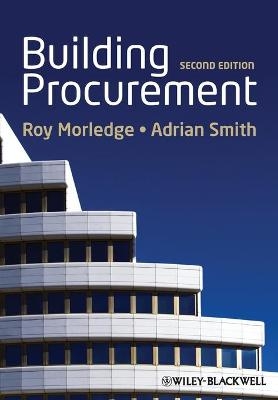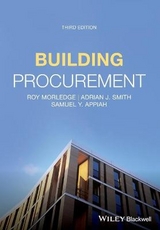
Building Procurement
Wiley-Blackwell (Verlag)
978-0-470-67243-3 (ISBN)
- Titel ist leider vergriffen;
keine Neuauflage - Artikel merken
As an industrial process, construction is unique in that the method of procurement of any built asset (building, infrastructure or process plant) defines many of the subsequent management processes that take place during the building phase a very different situation to the purchase of goods and services in most other industries. The procurement process is therefore central to the success of any construction project and many of the problems which impact construction projects can be traced back to the procurement phase, so a good understanding of the methods of procurement and the influence it has on project success is essential for all those working in the industry. Much has changed in the global construction industry since publication of the first edition of Building Procurement, for example the global liquidity & banking crisis and the debt burden of many major economies. This new edition has been rewritten to take account of these significant developments, but at its core it continues to provide a critical examination and review of current procurement practices in the UK, continental Europe (including EU procurement procedures), China and the USA.
It retains its original strong emphasis on the need for clients to establish achievable objectives which reflect the project business case and focuses on development of suitable strategies and management structures to meet those objectives in the current construction climate. Building Procurement will be essential reading for senior undergraduate and postgraduate students of construction management and practitioners working in all areas of construction management. Review of the first edition "...a thorough and comprehensive investigation of building procurement..." Construction Management and Economics
Roy Morledge isProfessor of Construction Procurement in the School of Architecture, Design and Built Environment at Nottingham Trent University. Adrian Smith is a Senior Consultant in Procurement and Project Management at Stradia Ltd, Sheffield and a Senior Consultant to the College of Estate Management, Reading.
Preface to the second edition xii 1 Introduction 1 2 Procurement strategy: a literature review 6 Introduction and early history 6 Procurement strategy selection models 7 Towards a broader view 8 Defining project success 10 Team relationships, supply chain management and communication and their effect on project performance 11 Teamwork and team performance 11 Partnering: introduction and early development 12 Partnering: a critical review 13 Partnering variants 15 Partnering dissected 16 Procurement and multicultural teams 17 Supply chain management 17 The role of the client in the procurement process 18 The interrelationship between the components of the overall procurement approach: strategic procurement management 19 Legal and contractual issues, including public sector procurement legislation, and their effect on project performance 20 International procurement comparisons and the impact of cultural differences 22 Risk allocation and reward 24 Bid evaluation techniques 25 Environmental and sustainability issues and the procurement of construction work 27 Conclusion 28 References 29 3 Principles of strategic procurement 42 Introduction 42 Procurement: a review of theory and practice 44 A strategic approach to procurement 45 Components of the procurement process 46 Conclusion 53 References 54 4 Public sector projects 55 Introduction: why should public sector projects be different? 55 What constitutes the public sector? 56 Central government 57 Local government 63 Best value 64 Procurement rules: European Union principles and procedures 64 Non-discrimination and transparency: the role of the EU 64 EU Directives 65 Tendering 69 Framework agreements 72 Electronic auctions 74 Sustainability and environmental issues 75 Timescales 76 Award procedures 76 The Remedies Directive 78 Enforcement of EU Directives 79 References 79 5 Project initiation 81 Introduction 81 Strategic fit 82 Payback 82 Assessment of options 86 Achievability 87 Affordability 87 Project initiation 87 Prioritisation of objectives 88 Conclusion 91 References 91 6 Briefing and the design process 92 Introduction 92 Project briefing: an overview 92 Types of construction client 94 Questions to determine the type of client 96 Project complexity 97 The briefing process: a historical perspective 98 Developing the strategic brief 100 The project execution plan (PEP) 101 What issues does the PEP need to address? 101 When should it be prepared? 103 Who prepares the PEP? 104 How is the PEP prepared? 104 Project briefing: the case of hospitals 105 Critical factors for success in the briefing process 106 References 108 7 Procurement strategies and procurement routes 110 Introduction 110 Procurement strategy 115 Procurement routes 117 Factors to be considered in selecting a procurement route 119 Factors outside the control of the project team 119 Client resources 120 Project characteristics 120 Ability to make changes 120 Risk management 120 Cost issues 121 Project timing 121 Construction times 122 Performance 122 Selection of a procurement route 123 Procurement routes: a review 126 Traditional (design bid build) 126 Design and build 129 Measurement (remeasurement or measure and value) 134 Construction management 135 Management contracting 137 Design and manage 139 References 139 8 Project team selection 141 Introduction 141 The selection process 143 Prequalification 143 Tender invitation and submission 146 Tender evaluation 146 Interview 147 Award of the contract 148 Selecting a consultant 148 Selecting a contractor 151 References 152 9 Managing the procurement process 153 Introduction 153 The project manager 154 First tasks of the project manager 155 Developing the project execution plan 156 Identifying the project team 156 Implementing the procurement strategy 157 Project resources 157 Financial resources 157 Human resources 157 Physical resources 158 Temporary organisational structure 159 Contractual arrangements 159 Systems and controls 159 Time management 160 Design management 162 Design risk 163 Cost management 164 Quality control 167 Change control 168 Commissioning 169 Occupation and take-over 170 Conclusion 170 References 170 10 The value of design 171 Introduction 171 Considering value in the business context 172 The value of good design 173 Managing value 175 Value management 176 Value engineering 179 References 181 11 Risk management 182 Introduction 182 Risk and uncertainty 183 Types of risk 183 Risk management strategies 184 Identifying risk 185 Assumption analysis 185 Checklists 185 Brainstorming 187 Delphi technique 187 Cause and effect of risk 187 Examples of risks 188 Analysing risk 189 Qualitative assessment 189 Quantitative assessment 190 Choosing a risk management strategy 194 Risk management strategies 195 Risk allocation 196 The empty chair theory 197 Monitoring and controlling risk 197 References 198 Further reading 198 12 Partnering culture and the management of relationships 199 Introduction 199 The Latham review and subsequent developments 199 The rise of collaborative approaches to procurement 200 Collaborative approaches to construction work 201 Contractual approaches to collaboration 202 The JCT forms of contract including the Standard Form of Building Contract 202 The New Engineering Contract Engineering and Construction Contract (NEC ECC) Edition 3 202 The ACA Project Partnering Contract (PPC 2000) 203 Perform21 Public Sector Partnering Contract (PSPC) 203 Target cost contracts 204 What advantages does partnering bring? 205 Managing a successful partnering arrangement 205 The role of the workshop facilitator 206 Facilitation guidelines 207 Team composition 208 Managing relationships 208 Why is relationship management important? 209 Establishing the cultural fit 210 Mutual objectives 212 Team development 213 The nature of trust 216 Maintenance of the relationship 218 The project supply chain 219 The holistic approach 221 The bicameral approach 221 The unilateral approach 221 The collaborative approach 222 Conclusion 222 References 223 13 Privately financed public sector projects 225 Introduction 225 Historical development 225 Modern models for privatisation 229 Outright privatisation 229 Participative privately financed techniques 230 Corporatisation and the use of semi-private (mixed) companies 230 Management contracts 232 The leasing or build lease transfer (BLT) model 232 Prefinancing 233 Mixed models 234 Concession-based methods 234 Public private partnerships (PPPs) 238 The Private Finance Initiative 239 Genesis 239 Problems 240 Current developments 253 Conclusion 254 References 254 14 Construction procurement: Europe, the Middle East and China 257 Introduction 257 Europe 258 The French system 258 The northern European approach 265 The Mediterranean approach 267 The Middle East 271 The People s Republic of China and the Hong Kong Special Autonomous Region 273 The Chinese construction industry 273 The construction professions 275 Opportunities for Western companies 275 Reference 276 15 Procurement of work to heritage buildings 277 Introduction 277 The heritage challenge 278 Procurement: The heritage context 280 The value of built heritage 284 The importance of cultural significance 286 Statutory protection for heritage buildings 287 Listed buildings 288 Conservation areas 289 Scheduled monuments 289 World Heritage Sites 289 Managing change in the historic environment 290 Planning for conservation 290 The role of the conservation advisor 292 Procurement processes and procedures 293 The investigation contract 294 A case study in the procurement of work to historic buildings: The Derby roundhouse 295 The existing buildings: historical background 297 The genesis of the project 302 The final scheme 302 Site surveys and pre-tender investigations 308 The tender process 308 The partnering process 309 Post-contract processes 310 Practical issues on site 310 References 312 16 Summary 316 Appendix: Procurement route selection checklists 320 Index 324
| Verlagsort | Hoboken |
|---|---|
| Sprache | englisch |
| Maße | 183 x 250 mm |
| Gewicht | 610 g |
| Themenwelt | Technik ► Bauwesen |
| ISBN-10 | 0-470-67243-9 / 0470672439 |
| ISBN-13 | 978-0-470-67243-3 / 9780470672433 |
| Zustand | Neuware |
| Informationen gemäß Produktsicherheitsverordnung (GPSR) | |
| Haben Sie eine Frage zum Produkt? |
aus dem Bereich



